In-Depth Review: Psychopharmacology of Medical Cannabis Research
VerifiedAdded on 2023/06/03
|7
|1783
|429
Report
AI Summary
This report critically reviews a research paper on the psychopharmacology of medical cannabis, focusing on its effects on anxiety, depression, and stress. The study, which utilized the Strainprint App to track patient responses to different dosages of cannabis, found that cannabis use can be beneficial for managing anxiety and stress, with low doses being more effective for depression. The combination of THC and CBD also plays a crucial role, with low THC and high CBD concentrations being linked to improved depression levels, while high concentrations of both are better for stress relief. However, the study also revealed that continued cannabis use may worsen depression. The report highlights the study's strengths, such as its use of the Strainprint App and a large sample size, as well as its weaknesses, including self-selection bias and the lack of a control group. Future research should focus on controlled samples and predetermined doses to better understand the impacts of medical cannabis. A social media post summarizing the findings is also included, emphasizing the importance of proper dosage and potential long-term effects.
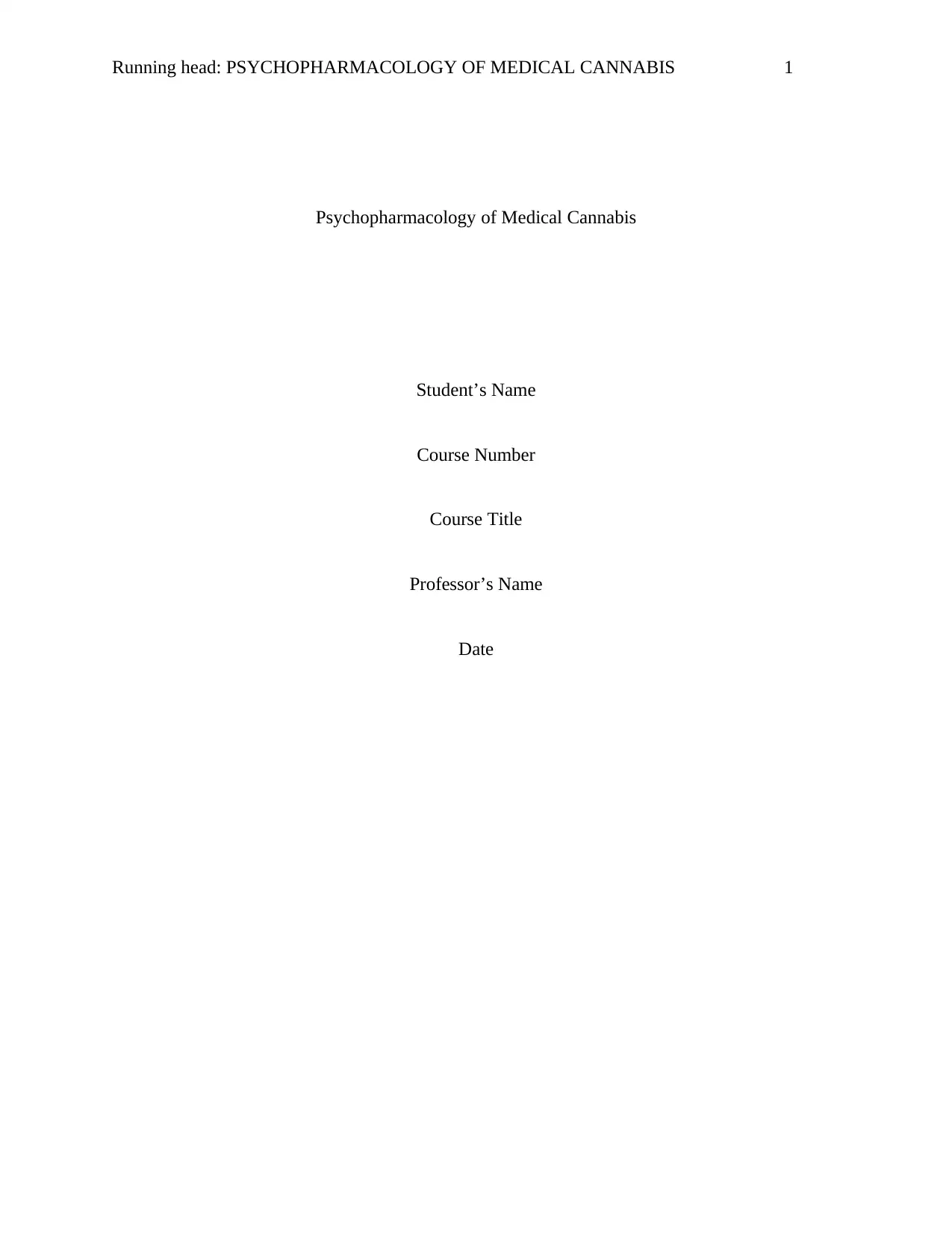
Running head: PSYCHOPHARMACOLOGY OF MEDICAL CANNABIS 1
Psychopharmacology of Medical Cannabis
Student’s Name
Course Number
Course Title
Professor’s Name
Date
Psychopharmacology of Medical Cannabis
Student’s Name
Course Number
Course Title
Professor’s Name
Date
Paraphrase This Document
Need a fresh take? Get an instant paraphrase of this document with our AI Paraphraser

PSYCHOPHARMACOLOGY OF MEDICAL CANNABIS 2
Purpose
The purpose of the study conducted by Carrier Cuttler, Alexander Spradlin, and Ryan
McLaughlin was to evaluate the effects of long-term as well as the short-term use of cannabis.
The study focused on both the negative effects as well as the positive impacts. There was a
comprehensive knowledge of the use of cannabis to reduce the negative effects (Anderson et al,
2010). However, there was an information gap in relation to the impacts which result from
specific dosages of cannabis. The research focused on the mental impacts which are as a result of
different dosages of tetrahydrocannabinol (THC), which is the psychoactive substance in
cannabis and cannabidiol (CBD). The authors focused on depression, anxiety, and stress as the
indicators for the effects of cannabis. The study was focusing on medical marijuana users who
experience the mentioned conditions (Cuttler, Spradlin & McLaughlin, 2018).
Result
The results indicated the positive response of anxiety and stress in relation to cannabis
use. Fifty percent of the cannabis users reported that after taking cannabis their depression got
better. The numbers were higher for anxiety and stress. Fifty-eight of the respondents reporting
that their anxiety or stress levels went down after using cannabis. It shows that cannabis is more
preferred as a medical solution for anxiety and stress over depression. An interesting observation
from the study is that low doses of cannabis produced better results in depression and anxiety.
The respondents reported that two puffs were sufficient to reduce their anxiety and depression
levels. In order to reduce the levels of stress in a patient, ten-puff dose or more is preferred
(Castle et al, 2011).
The study also revealed that the combination of THC and CBD was a key determinant in
the level of mental effect it would have on the patient. A low THC and a high CBD was linked to
Purpose
The purpose of the study conducted by Carrier Cuttler, Alexander Spradlin, and Ryan
McLaughlin was to evaluate the effects of long-term as well as the short-term use of cannabis.
The study focused on both the negative effects as well as the positive impacts. There was a
comprehensive knowledge of the use of cannabis to reduce the negative effects (Anderson et al,
2010). However, there was an information gap in relation to the impacts which result from
specific dosages of cannabis. The research focused on the mental impacts which are as a result of
different dosages of tetrahydrocannabinol (THC), which is the psychoactive substance in
cannabis and cannabidiol (CBD). The authors focused on depression, anxiety, and stress as the
indicators for the effects of cannabis. The study was focusing on medical marijuana users who
experience the mentioned conditions (Cuttler, Spradlin & McLaughlin, 2018).
Result
The results indicated the positive response of anxiety and stress in relation to cannabis
use. Fifty percent of the cannabis users reported that after taking cannabis their depression got
better. The numbers were higher for anxiety and stress. Fifty-eight of the respondents reporting
that their anxiety or stress levels went down after using cannabis. It shows that cannabis is more
preferred as a medical solution for anxiety and stress over depression. An interesting observation
from the study is that low doses of cannabis produced better results in depression and anxiety.
The respondents reported that two puffs were sufficient to reduce their anxiety and depression
levels. In order to reduce the levels of stress in a patient, ten-puff dose or more is preferred
(Castle et al, 2011).
The study also revealed that the combination of THC and CBD was a key determinant in
the level of mental effect it would have on the patient. A low THC and a high CBD was linked to
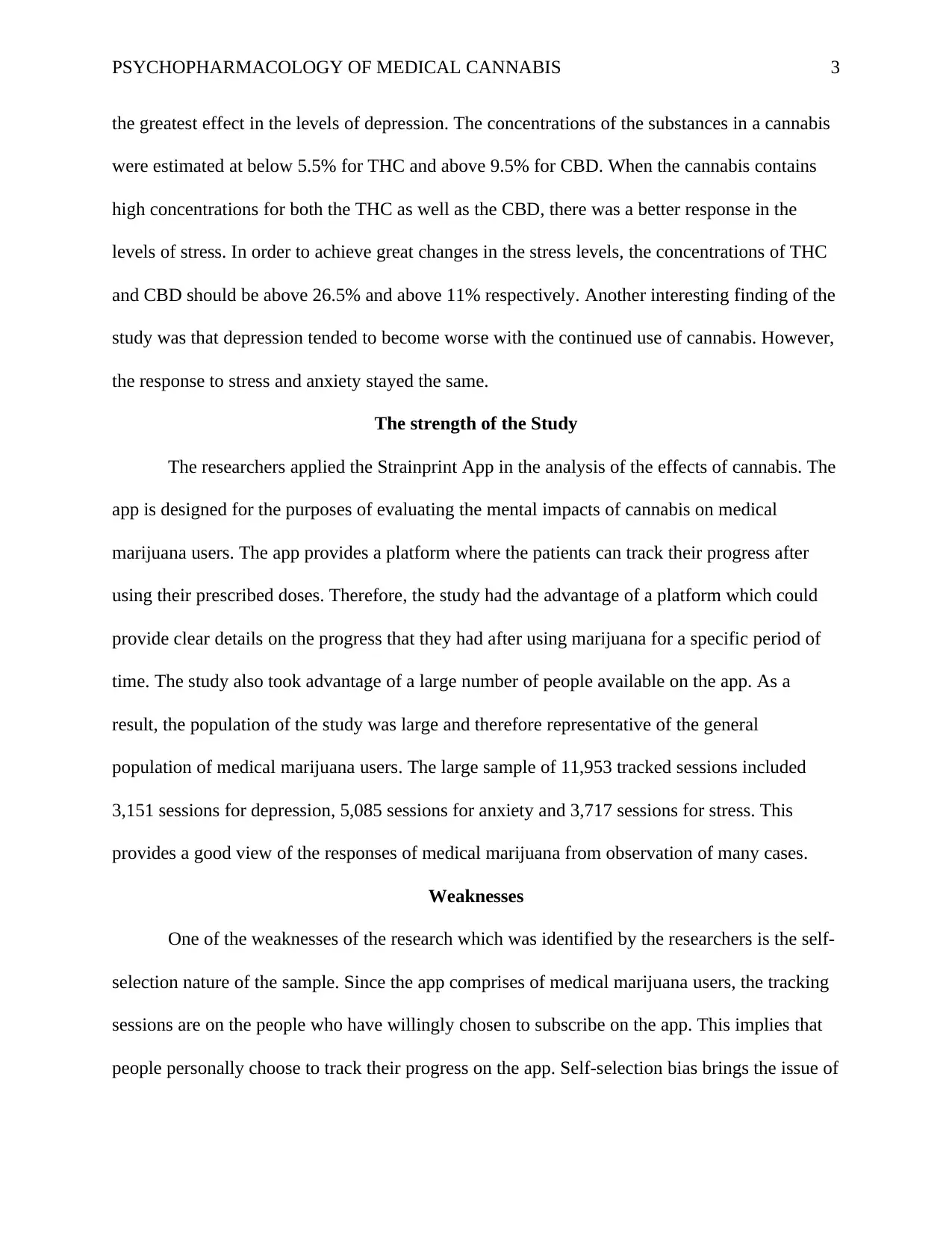
PSYCHOPHARMACOLOGY OF MEDICAL CANNABIS 3
the greatest effect in the levels of depression. The concentrations of the substances in a cannabis
were estimated at below 5.5% for THC and above 9.5% for CBD. When the cannabis contains
high concentrations for both the THC as well as the CBD, there was a better response in the
levels of stress. In order to achieve great changes in the stress levels, the concentrations of THC
and CBD should be above 26.5% and above 11% respectively. Another interesting finding of the
study was that depression tended to become worse with the continued use of cannabis. However,
the response to stress and anxiety stayed the same.
The strength of the Study
The researchers applied the Strainprint App in the analysis of the effects of cannabis. The
app is designed for the purposes of evaluating the mental impacts of cannabis on medical
marijuana users. The app provides a platform where the patients can track their progress after
using their prescribed doses. Therefore, the study had the advantage of a platform which could
provide clear details on the progress that they had after using marijuana for a specific period of
time. The study also took advantage of a large number of people available on the app. As a
result, the population of the study was large and therefore representative of the general
population of medical marijuana users. The large sample of 11,953 tracked sessions included
3,151 sessions for depression, 5,085 sessions for anxiety and 3,717 sessions for stress. This
provides a good view of the responses of medical marijuana from observation of many cases.
Weaknesses
One of the weaknesses of the research which was identified by the researchers is the self-
selection nature of the sample. Since the app comprises of medical marijuana users, the tracking
sessions are on the people who have willingly chosen to subscribe on the app. This implies that
people personally choose to track their progress on the app. Self-selection bias brings the issue of
the greatest effect in the levels of depression. The concentrations of the substances in a cannabis
were estimated at below 5.5% for THC and above 9.5% for CBD. When the cannabis contains
high concentrations for both the THC as well as the CBD, there was a better response in the
levels of stress. In order to achieve great changes in the stress levels, the concentrations of THC
and CBD should be above 26.5% and above 11% respectively. Another interesting finding of the
study was that depression tended to become worse with the continued use of cannabis. However,
the response to stress and anxiety stayed the same.
The strength of the Study
The researchers applied the Strainprint App in the analysis of the effects of cannabis. The
app is designed for the purposes of evaluating the mental impacts of cannabis on medical
marijuana users. The app provides a platform where the patients can track their progress after
using their prescribed doses. Therefore, the study had the advantage of a platform which could
provide clear details on the progress that they had after using marijuana for a specific period of
time. The study also took advantage of a large number of people available on the app. As a
result, the population of the study was large and therefore representative of the general
population of medical marijuana users. The large sample of 11,953 tracked sessions included
3,151 sessions for depression, 5,085 sessions for anxiety and 3,717 sessions for stress. This
provides a good view of the responses of medical marijuana from observation of many cases.
Weaknesses
One of the weaknesses of the research which was identified by the researchers is the self-
selection nature of the sample. Since the app comprises of medical marijuana users, the tracking
sessions are on the people who have willingly chosen to subscribe on the app. This implies that
people personally choose to track their progress on the app. Self-selection bias brings the issue of
⊘ This is a preview!⊘
Do you want full access?
Subscribe today to unlock all pages.

Trusted by 1+ million students worldwide
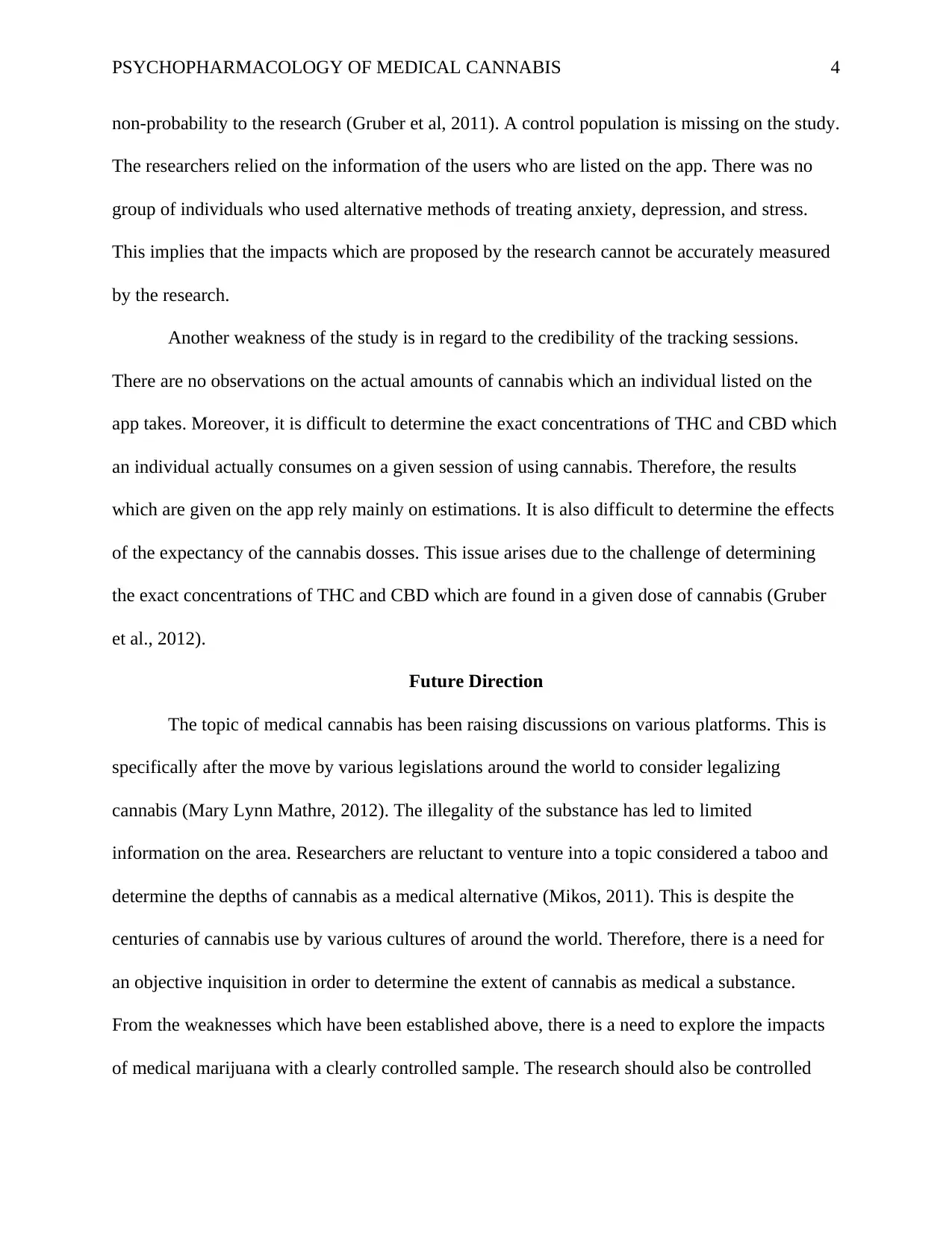
PSYCHOPHARMACOLOGY OF MEDICAL CANNABIS 4
non-probability to the research (Gruber et al, 2011). A control population is missing on the study.
The researchers relied on the information of the users who are listed on the app. There was no
group of individuals who used alternative methods of treating anxiety, depression, and stress.
This implies that the impacts which are proposed by the research cannot be accurately measured
by the research.
Another weakness of the study is in regard to the credibility of the tracking sessions.
There are no observations on the actual amounts of cannabis which an individual listed on the
app takes. Moreover, it is difficult to determine the exact concentrations of THC and CBD which
an individual actually consumes on a given session of using cannabis. Therefore, the results
which are given on the app rely mainly on estimations. It is also difficult to determine the effects
of the expectancy of the cannabis dosses. This issue arises due to the challenge of determining
the exact concentrations of THC and CBD which are found in a given dose of cannabis (Gruber
et al., 2012).
Future Direction
The topic of medical cannabis has been raising discussions on various platforms. This is
specifically after the move by various legislations around the world to consider legalizing
cannabis (Mary Lynn Mathre, 2012). The illegality of the substance has led to limited
information on the area. Researchers are reluctant to venture into a topic considered a taboo and
determine the depths of cannabis as a medical alternative (Mikos, 2011). This is despite the
centuries of cannabis use by various cultures of around the world. Therefore, there is a need for
an objective inquisition in order to determine the extent of cannabis as medical a substance.
From the weaknesses which have been established above, there is a need to explore the impacts
of medical marijuana with a clearly controlled sample. The research should also be controlled
non-probability to the research (Gruber et al, 2011). A control population is missing on the study.
The researchers relied on the information of the users who are listed on the app. There was no
group of individuals who used alternative methods of treating anxiety, depression, and stress.
This implies that the impacts which are proposed by the research cannot be accurately measured
by the research.
Another weakness of the study is in regard to the credibility of the tracking sessions.
There are no observations on the actual amounts of cannabis which an individual listed on the
app takes. Moreover, it is difficult to determine the exact concentrations of THC and CBD which
an individual actually consumes on a given session of using cannabis. Therefore, the results
which are given on the app rely mainly on estimations. It is also difficult to determine the effects
of the expectancy of the cannabis dosses. This issue arises due to the challenge of determining
the exact concentrations of THC and CBD which are found in a given dose of cannabis (Gruber
et al., 2012).
Future Direction
The topic of medical cannabis has been raising discussions on various platforms. This is
specifically after the move by various legislations around the world to consider legalizing
cannabis (Mary Lynn Mathre, 2012). The illegality of the substance has led to limited
information on the area. Researchers are reluctant to venture into a topic considered a taboo and
determine the depths of cannabis as a medical alternative (Mikos, 2011). This is despite the
centuries of cannabis use by various cultures of around the world. Therefore, there is a need for
an objective inquisition in order to determine the extent of cannabis as medical a substance.
From the weaknesses which have been established above, there is a need to explore the impacts
of medical marijuana with a clearly controlled sample. The research should also be controlled
Paraphrase This Document
Need a fresh take? Get an instant paraphrase of this document with our AI Paraphraser
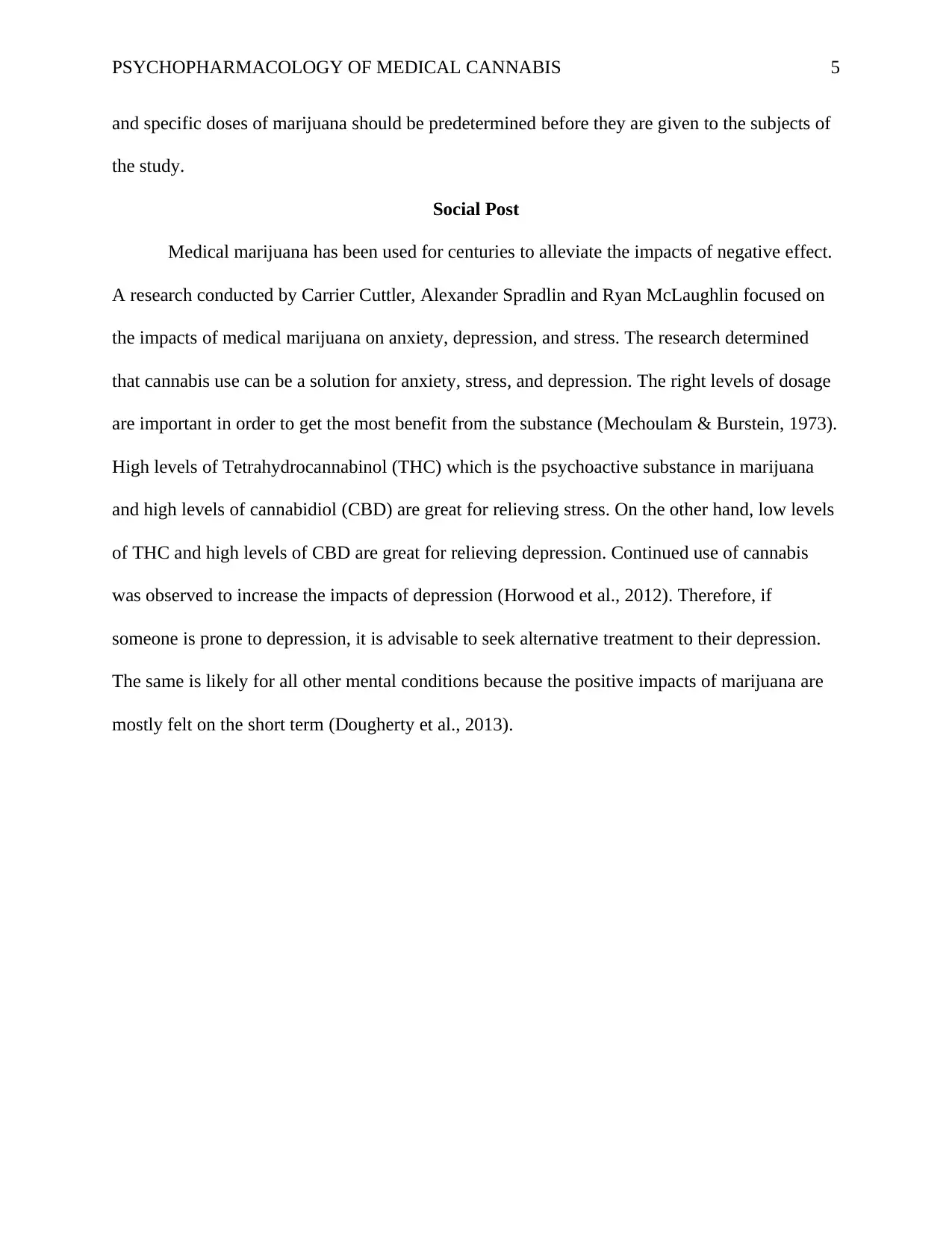
PSYCHOPHARMACOLOGY OF MEDICAL CANNABIS 5
and specific doses of marijuana should be predetermined before they are given to the subjects of
the study.
Social Post
Medical marijuana has been used for centuries to alleviate the impacts of negative effect.
A research conducted by Carrier Cuttler, Alexander Spradlin and Ryan McLaughlin focused on
the impacts of medical marijuana on anxiety, depression, and stress. The research determined
that cannabis use can be a solution for anxiety, stress, and depression. The right levels of dosage
are important in order to get the most benefit from the substance (Mechoulam & Burstein, 1973).
High levels of Tetrahydrocannabinol (THC) which is the psychoactive substance in marijuana
and high levels of cannabidiol (CBD) are great for relieving stress. On the other hand, low levels
of THC and high levels of CBD are great for relieving depression. Continued use of cannabis
was observed to increase the impacts of depression (Horwood et al., 2012). Therefore, if
someone is prone to depression, it is advisable to seek alternative treatment to their depression.
The same is likely for all other mental conditions because the positive impacts of marijuana are
mostly felt on the short term (Dougherty et al., 2013).
and specific doses of marijuana should be predetermined before they are given to the subjects of
the study.
Social Post
Medical marijuana has been used for centuries to alleviate the impacts of negative effect.
A research conducted by Carrier Cuttler, Alexander Spradlin and Ryan McLaughlin focused on
the impacts of medical marijuana on anxiety, depression, and stress. The research determined
that cannabis use can be a solution for anxiety, stress, and depression. The right levels of dosage
are important in order to get the most benefit from the substance (Mechoulam & Burstein, 1973).
High levels of Tetrahydrocannabinol (THC) which is the psychoactive substance in marijuana
and high levels of cannabidiol (CBD) are great for relieving stress. On the other hand, low levels
of THC and high levels of CBD are great for relieving depression. Continued use of cannabis
was observed to increase the impacts of depression (Horwood et al., 2012). Therefore, if
someone is prone to depression, it is advisable to seek alternative treatment to their depression.
The same is likely for all other mental conditions because the positive impacts of marijuana are
mostly felt on the short term (Dougherty et al., 2013).
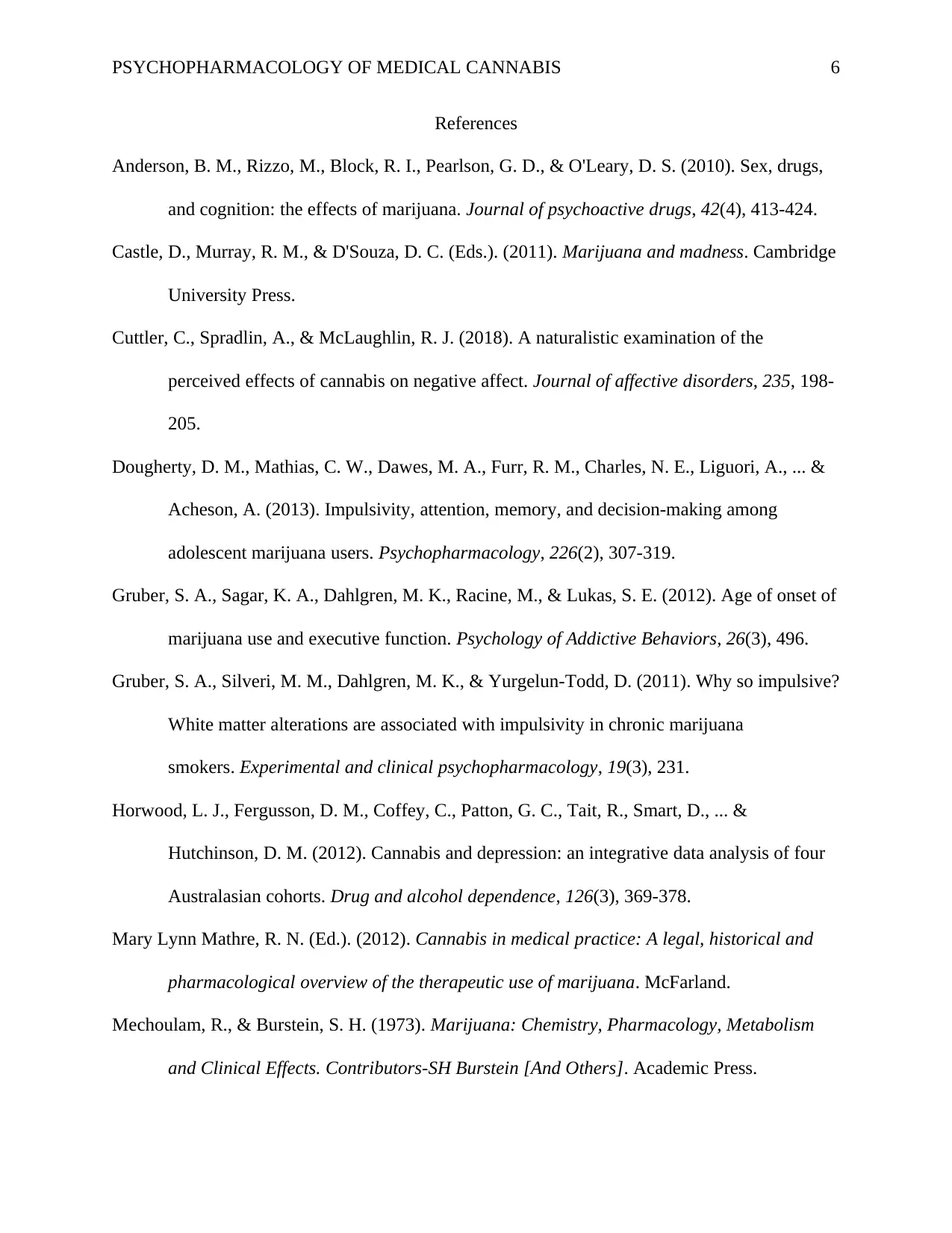
PSYCHOPHARMACOLOGY OF MEDICAL CANNABIS 6
References
Anderson, B. M., Rizzo, M., Block, R. I., Pearlson, G. D., & O'Leary, D. S. (2010). Sex, drugs,
and cognition: the effects of marijuana. Journal of psychoactive drugs, 42(4), 413-424.
Castle, D., Murray, R. M., & D'Souza, D. C. (Eds.). (2011). Marijuana and madness. Cambridge
University Press.
Cuttler, C., Spradlin, A., & McLaughlin, R. J. (2018). A naturalistic examination of the
perceived effects of cannabis on negative affect. Journal of affective disorders, 235, 198-
205.
Dougherty, D. M., Mathias, C. W., Dawes, M. A., Furr, R. M., Charles, N. E., Liguori, A., ... &
Acheson, A. (2013). Impulsivity, attention, memory, and decision-making among
adolescent marijuana users. Psychopharmacology, 226(2), 307-319.
Gruber, S. A., Sagar, K. A., Dahlgren, M. K., Racine, M., & Lukas, S. E. (2012). Age of onset of
marijuana use and executive function. Psychology of Addictive Behaviors, 26(3), 496.
Gruber, S. A., Silveri, M. M., Dahlgren, M. K., & Yurgelun-Todd, D. (2011). Why so impulsive?
White matter alterations are associated with impulsivity in chronic marijuana
smokers. Experimental and clinical psychopharmacology, 19(3), 231.
Horwood, L. J., Fergusson, D. M., Coffey, C., Patton, G. C., Tait, R., Smart, D., ... &
Hutchinson, D. M. (2012). Cannabis and depression: an integrative data analysis of four
Australasian cohorts. Drug and alcohol dependence, 126(3), 369-378.
Mary Lynn Mathre, R. N. (Ed.). (2012). Cannabis in medical practice: A legal, historical and
pharmacological overview of the therapeutic use of marijuana. McFarland.
Mechoulam, R., & Burstein, S. H. (1973). Marijuana: Chemistry, Pharmacology, Metabolism
and Clinical Effects. Contributors-SH Burstein [And Others]. Academic Press.
References
Anderson, B. M., Rizzo, M., Block, R. I., Pearlson, G. D., & O'Leary, D. S. (2010). Sex, drugs,
and cognition: the effects of marijuana. Journal of psychoactive drugs, 42(4), 413-424.
Castle, D., Murray, R. M., & D'Souza, D. C. (Eds.). (2011). Marijuana and madness. Cambridge
University Press.
Cuttler, C., Spradlin, A., & McLaughlin, R. J. (2018). A naturalistic examination of the
perceived effects of cannabis on negative affect. Journal of affective disorders, 235, 198-
205.
Dougherty, D. M., Mathias, C. W., Dawes, M. A., Furr, R. M., Charles, N. E., Liguori, A., ... &
Acheson, A. (2013). Impulsivity, attention, memory, and decision-making among
adolescent marijuana users. Psychopharmacology, 226(2), 307-319.
Gruber, S. A., Sagar, K. A., Dahlgren, M. K., Racine, M., & Lukas, S. E. (2012). Age of onset of
marijuana use and executive function. Psychology of Addictive Behaviors, 26(3), 496.
Gruber, S. A., Silveri, M. M., Dahlgren, M. K., & Yurgelun-Todd, D. (2011). Why so impulsive?
White matter alterations are associated with impulsivity in chronic marijuana
smokers. Experimental and clinical psychopharmacology, 19(3), 231.
Horwood, L. J., Fergusson, D. M., Coffey, C., Patton, G. C., Tait, R., Smart, D., ... &
Hutchinson, D. M. (2012). Cannabis and depression: an integrative data analysis of four
Australasian cohorts. Drug and alcohol dependence, 126(3), 369-378.
Mary Lynn Mathre, R. N. (Ed.). (2012). Cannabis in medical practice: A legal, historical and
pharmacological overview of the therapeutic use of marijuana. McFarland.
Mechoulam, R., & Burstein, S. H. (1973). Marijuana: Chemistry, Pharmacology, Metabolism
and Clinical Effects. Contributors-SH Burstein [And Others]. Academic Press.
⊘ This is a preview!⊘
Do you want full access?
Subscribe today to unlock all pages.

Trusted by 1+ million students worldwide
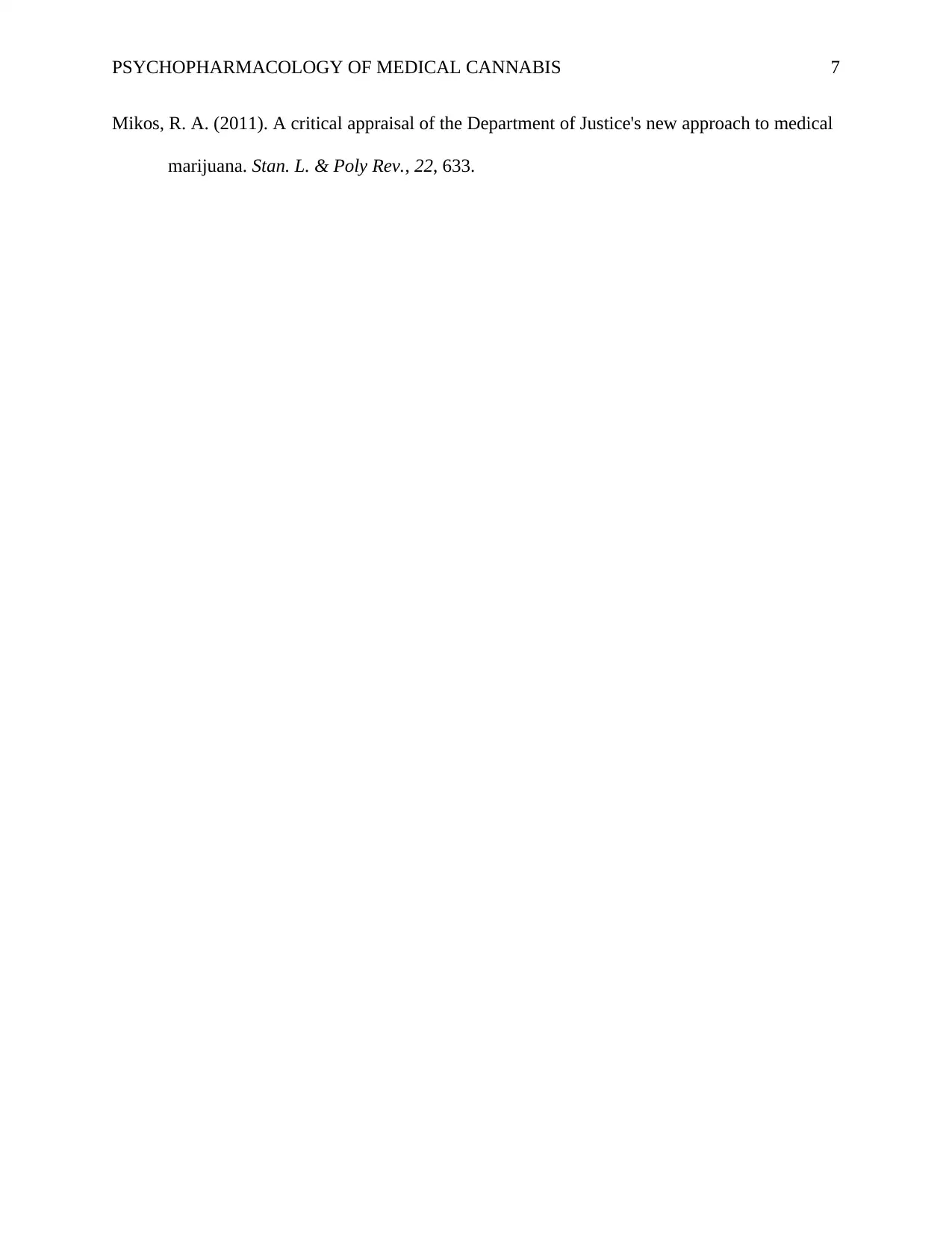
PSYCHOPHARMACOLOGY OF MEDICAL CANNABIS 7
Mikos, R. A. (2011). A critical appraisal of the Department of Justice's new approach to medical
marijuana. Stan. L. & Poly Rev., 22, 633.
Mikos, R. A. (2011). A critical appraisal of the Department of Justice's new approach to medical
marijuana. Stan. L. & Poly Rev., 22, 633.
1 out of 7
Related Documents
Your All-in-One AI-Powered Toolkit for Academic Success.
+13062052269
info@desklib.com
Available 24*7 on WhatsApp / Email
![[object Object]](/_next/static/media/star-bottom.7253800d.svg)
Unlock your academic potential
Copyright © 2020–2025 A2Z Services. All Rights Reserved. Developed and managed by ZUCOL.



